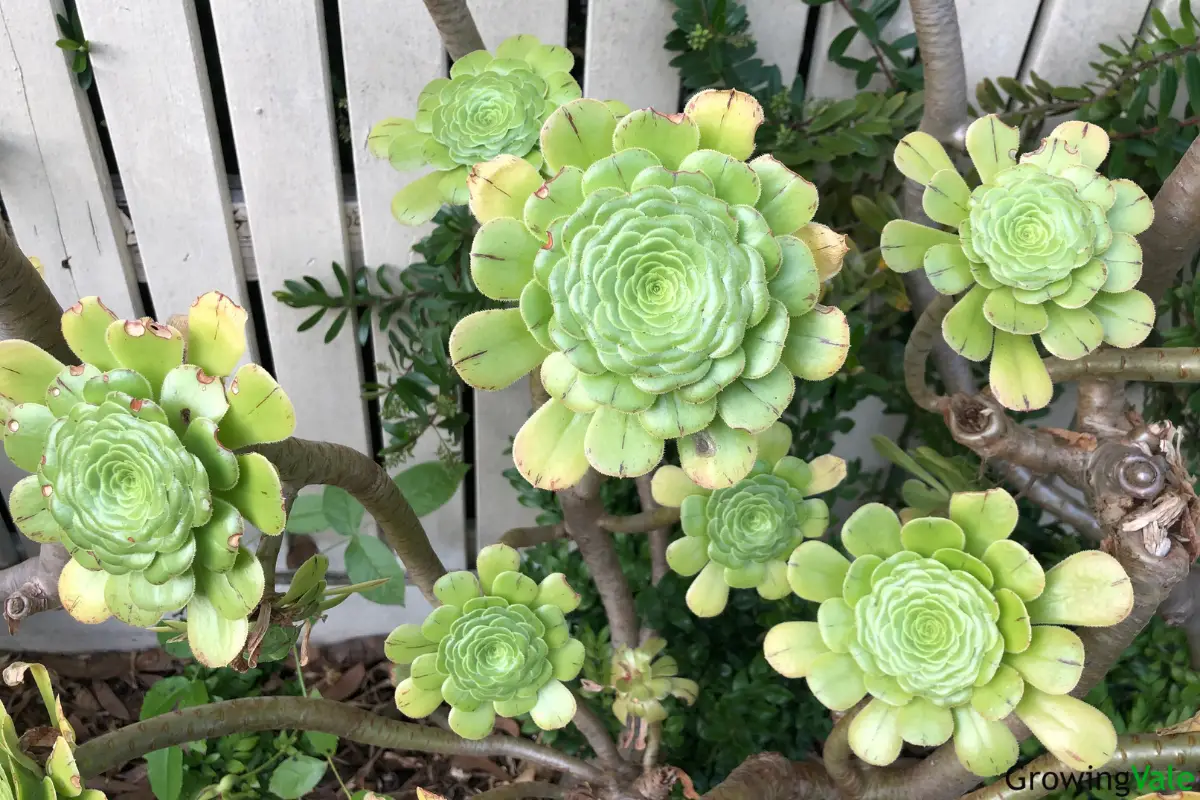Aeoniums (Aeonium spp.) are a small group of succulents that are easy to grow, drought-hardy, and quite cold tolerant. They make ideal houseplants as they require a minimal amount of care and maintenance.
The most interesting feature of Aeoniums is the almost symmetrical positioning of their fleshy leaves to make perfect rosettes. They range in size from small, almost miniature plants to much taller plants that have the rosettes form on the end of long stems.
The individual leaves can also display an interesting array of colors depending on their growing conditions. In optimum conditions, the leaves will be all green. However, if the plant is experiencing some stress, you can witness the leaves displaying brightly colored margins from yellow to pink and even red.
Professional growers and hobbyists will often induce a little stress to their Aeoniums to make these different colors appear. This is not harmful to the plant itself but can result in some amazing displays.
History
The name Aeonium is derived from the Greek word “aionos” which means ageless.
Aeoniums originate from the Atlantic islands with a couple of species found in East Africa and Yemen. They were originally quite widespread throughout North Africa and the Mediterranean.
However, the spread of the Sahara desert has forced them to move toward the more coastal areas and into mountainous regions that don’t experience as much searing heat and sun.
Plant Facts
| Scientific name | Aeonium spp. |
| Common names | Aeonium |
| Genus | Aeonium |
| Family | Crassulaceae |
| Height | 5 inches to 6 feet depending on species |
| Width | Each rosette can be 1 to 6 inches across |
| USDA Plant Hardiness Zone | 9 to 11 |
| Origin | Canary Islands, Madeira, Morocco, Arabia, Africa |
| Flower colors | Pink, yellow & white (flowers only occur on mature plants |
| Blooming season | Late winter to spring |
| Plant/Flower special features | Drought and cold tolerant |
How to Plant and Grow Aeonium Succulents
Aeonium succulent can be grown outdoors in the ground in warmer climates. However, most people grow them in pots and then bring them indoors before the first frost is expected.
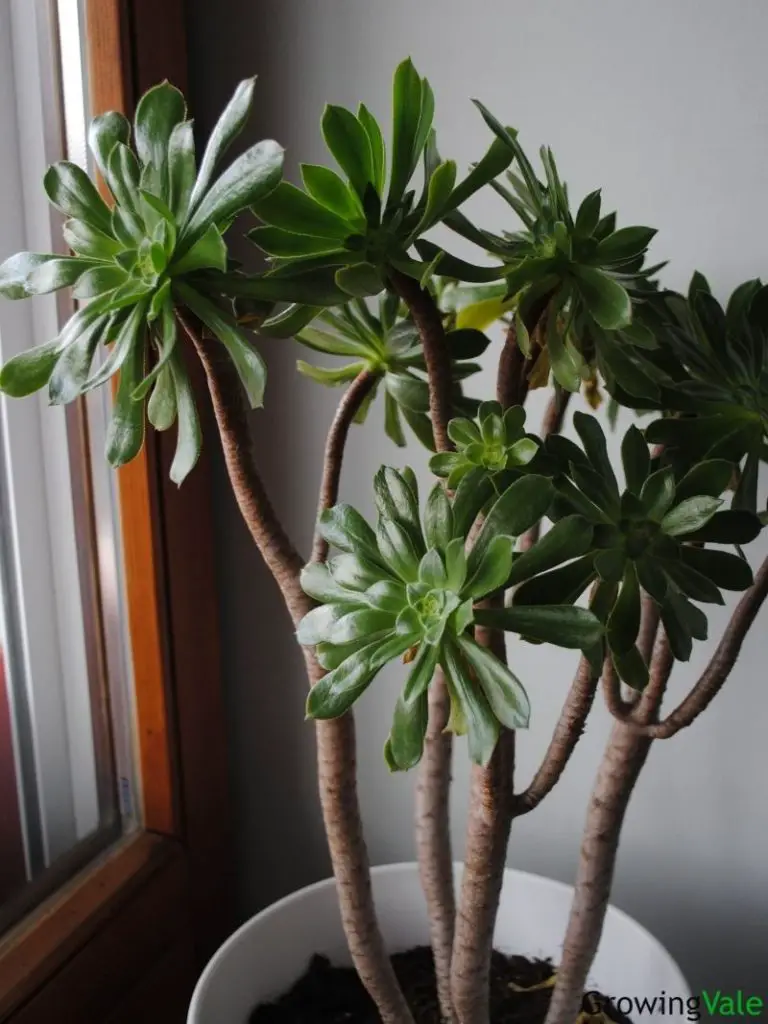
In warmer areas, Aeoniums are used as mass landscape plantings outdoors to produce an attractive and low-maintenance display.
If your area receives periods of hot sun in summer, it’s best to provide some shelter to your Aeoniums as they tend to shrivel when they get too much heat from the sun.
That’s precisely why a lot of people prefer to grow Aeoniums in pots because they can be moved around to accommodate their needs.
Aeoniums are also quite slow-growing and many can take around 5 years before they bloom. The flowers are tiny and daisy-like in appearance. They’re usually arranged in a pyramid shape at the end of the flower stem. These make excellent long-lasting cut flowers.
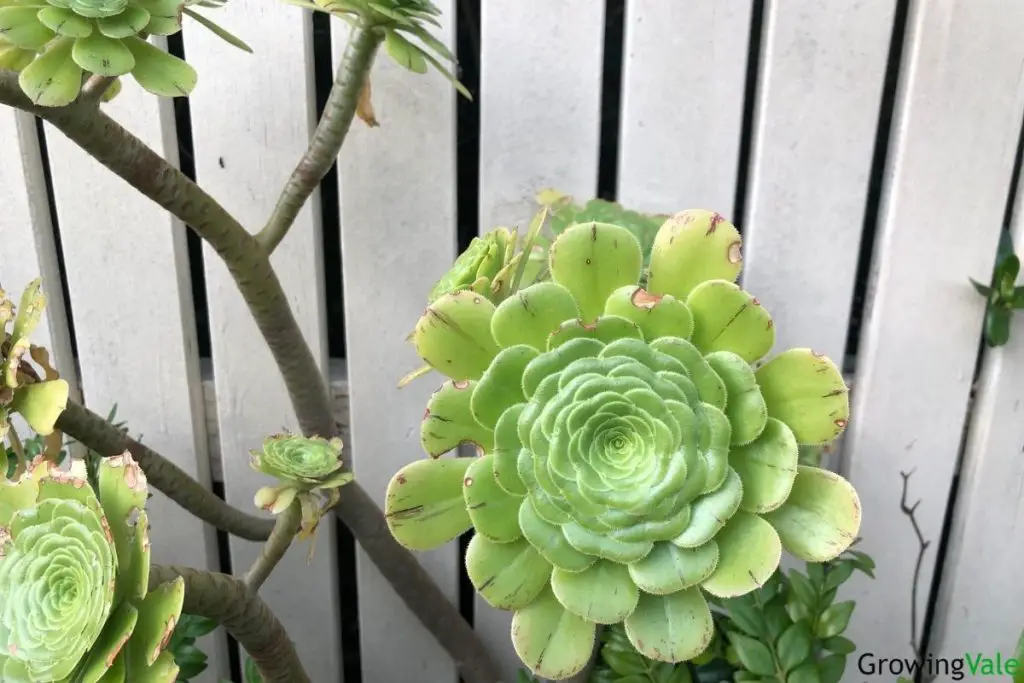
How to Propagate Aeonium
It’s best to propagate Aeoniums from stem cuttings. This plant is relatively easy to propagate and you can even use stem pieces that have fallen off the plant.
Here’s what you need to do:
- Cut off a piece of stem from a mature plant. Make sure that the stem piece has a rosette on the end.
- Place the stem piece in a cool, dry spot for about 3 days until the cut end callouses.
- Fill a tray or small pot with a mixture of half potting mix and half succulent mix or perlite.
- Put the cut end of the stem piece into the mix just deep enough so that it stands upright.
- Put the pot or tray in a brightly lit spot with indirect sunlight.
- Water the mix lightly about once a week.
- Once you determine that the cutting has developed roots, you can allow the top two inches of soil to dry out before applying more water.
Interestingly, Aeonium succulents are monocarpic. This means that the mother plant will die after it has flowered. However, if there are side shoots on the plant, these will continue to grow.
That’s why it’s important to propagate new plants from a mature one so if the mature plant dies, you’ll have more plants to replace it.
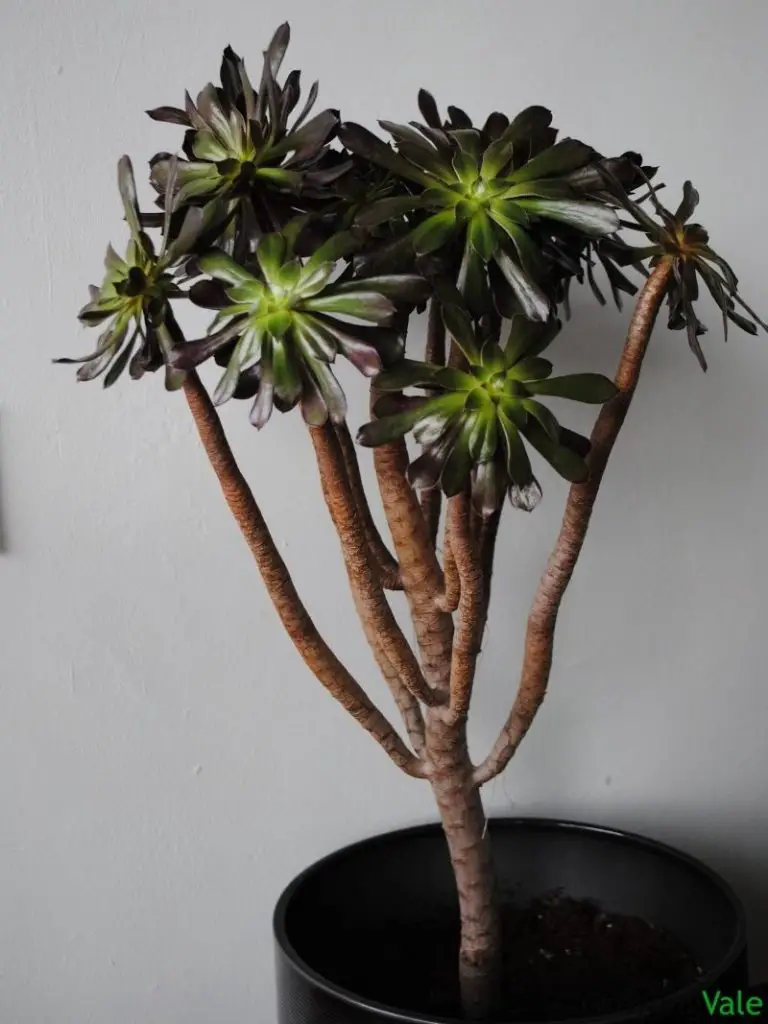
Care and Maintenance
Aeoniums are fairly low-maintenance plants. When grown in pots indoors, all they require is enough water so that they don’t dry out. They also benefit from the addition of a balanced fertilizer during their main growth period which is from winter to spring.
When grown outdoors, they prefer a temperate climate and need some protection from the hot sun in summer. It’s also important not to let the plants dry out. But, they also don’t like having wet feet.
Aeonium plants are easy to propagate and you can use the stems that have fallen off mature plants to grow new plants.
Soil
Aeoniums require a good potting mix that is free draining but doesn’t dry out easily. The best mix can be made up by using a regular potting mix and mixing it with perlite to add extra drainage.
These plants do need to have soil that is free draining but, unlike other succulents, they prefer some continuous moisture in the soil.
Water
Being succulents, Aeoniums store moisture in their leaves and stems. Therefore, they have a fairly shallow root system. However, unlike other succulents such as cacti, they don’t like the soil to dry out.
The soil should always be moist but not wet. However, ensure that the plants don’t sit in water as this will cause root rot.
You can either use a moisture meter or just poke your finger into the top 1 or 2 inches of soil to determine when your plant needs more water.
Fertilizer
Aeoniums don’t require a lot of fertilizer but it’s a good idea to give them a balanced fertilizer during their growing season which is winter to spring. You should apply the fertilizer at half-strength and don’t fertilize in the summer while the plant is dormant.
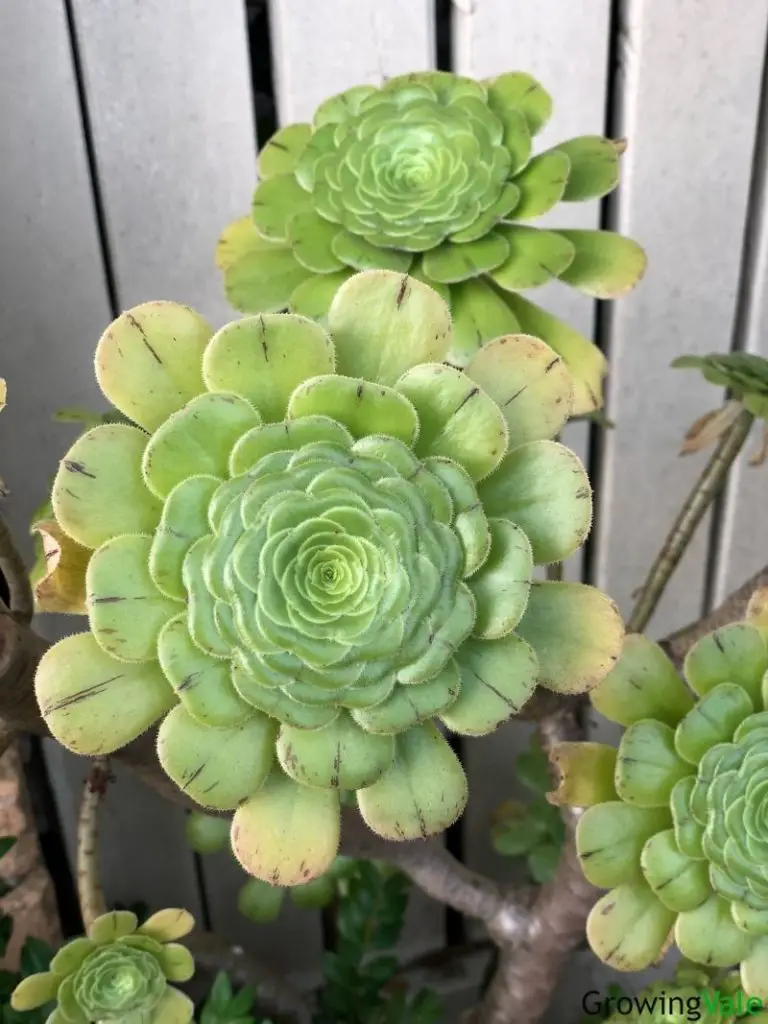
Sunlight
Aeoniums prefer to grow in full sun to part shade. In hot climates, it’s best to protect these plants from the midday and afternoon sun by giving them some shade.
When growing Aeoniums indoors, choose a bright spot with indirect sunlight.
Temperature and Humidity
Aeoniums prefer a Mediterranean climate that is not too hot or too cold. Most varieties will grow happily in USDA zones from 9 to 11. They grow best in temperatures from 65 to 75 degrees Fahrenheit and like damp conditions. However, they will tolerate temperatures from 40 to 100 degrees Fahrenheit.
The plants will put on new growth from winter to spring. In the heat of summer, Aeoniums may go dormant and their leaves may curl up to conserve moisture.
Pruning
Aeoniums generally don’t require a lot of pruning. However, if your plant starts to get leggy, you can reduce the length of the stem and leave only an inch or two. Use the pieces of stem that you’ve cut off to propagate new plants.
It’s best to prune your plants in the fall as they come into their optimum growth period from dormancy.
Pest and diseases
Like many other succulents and houseplants, Aeoniums can be attacked by insect pests such as mealybugs, aphids, and spider mites. These are easily controlled by spraying the plants with insecticidal soap and then rinsing or washing off the dead insects.
The most common disease that may affect Aeoniums is root rot. This can be avoided by ensuring the plant has adequate drainage and is never allowed to sit in water.
Uses of Aeoniums
Aeoniums are mainly grown for their ornamental value. They make interesting houseplants, especially if you have a collection of different species.
These plants are also commonly used in landscape plantings and rockeries. Especially in areas that experience relatively mild summers. Because Aeoniums are fairly low maintenance, they are commonly used in commercial landscape plantings.
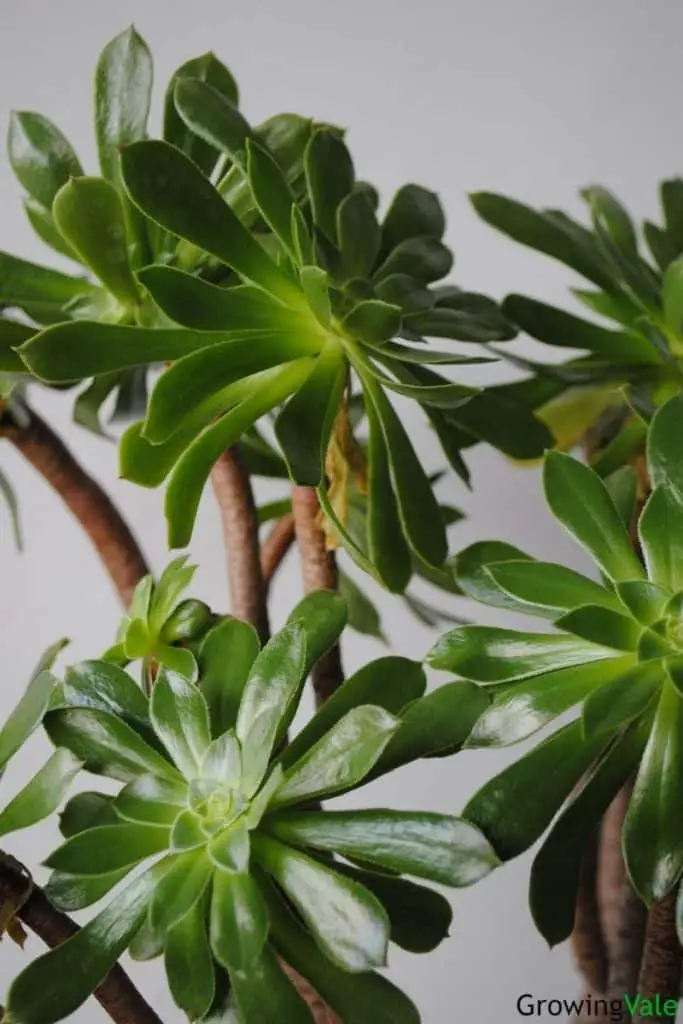
Common Varieties and Cultivars
Aeoniums include only 34 species. However, continuous breeding is being carried out in Japan, America, and Europe to develop new aeonium varieties and cultivars.
Here are some of the more common Aeonium varieties available today:
- A. tabuliforme
- A. smithii
- A. arboreum
- A. valverdense
- A. holochrysum
- A. davidbramwelli
- A. haworthii
- A. ‘Zwartkop’
- A. ‘Firecracker’
- A. ‘Ballerina’
- Aeonium ‘Sunburst’
Conclusion
Aeoniums are popular houseplants but can also be grown outdoors in temperate climates. These delightfully symmetrical succulents are easy to grow and will produce some interesting color variations in their leaves.
Unlike other succulents, Aeoniums do like to be kept moist but don’t like sitting in water. They make an interesting addition to your houseplant collection and are also great for mass planting in rockeries.
There are 35 species of Aeoniums ranging in size from miniature to large plants with tall stems. This provides succulent growers with plenty of choices to add to their collections.

